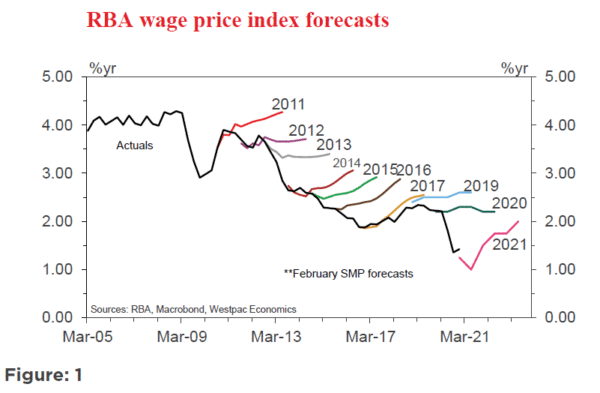The Reserve Bank Board meets next week on March 2.
While we have seen extraordinary developments in bond markets over the last week, I do not think they will impact the Bank’s key messages.
We expect there will be no change in the policy settings and that the conclusion from the February Statement by the Governor will be confirmed.
“The Board will not increase the cash rate until actual inflation is sustainably within the 2 to 3 per cent target range. For this to occur, wages growth will have to be materially higher than it is currently. This will require significant gains in employment and a return to a tight labour market. The Board does not expect these conditions to be met until 2024 at the earliest”.
Markets will closely scrutinise the Governor’s Statement for any evidence that the Board may be contemplating a change in its approach to Yield Curve Control (YCC) and Quantitative Easing (QE).
In the Governor’s speech at the National Press Club on February 3 following the Board meeting on February 2 the Governor noted that the Bank’s policy of purchasing three year bonds at the cash rate of 0.1% which was aimed at supporting its expectation that the Bank expected to hold the cash rate steady at 0.1% for three years would need to be reviewed by mid-2021 to decide whether to progress its purchase program from buying April 2024 bonds to buying November 2024 bonds.
Recently, markets have become convinced that the pivot to November bonds will not occur and by inference the Bank effectively declaring that the policy to hold the 0.1% cash rate steady for three years beyond April 2021 would no longer be the central outlook.
Westpac has argued consistently since the YCC policy was introduced that the time for a move away from the three year cash rate commitment would come when the Bank was not be prepared to argue convincingly that it expected the cash rate to hold for a further three years.
Based on our forecasts and our assessment of the strength of commitment from central banks globally to ensure the eventual achievement of their objectives we have not expected such a change in rhetoric around YCC until the first half of 2022.
Markets are strongly disagreeing.
Whereas the April 2024 bonds are trading at 0.13%, the November 2024 bonds are trading at 0.37%.
Reports on recent trading both yesterday and today were that the RBA bought two $3 billion tranches of April 2024 bonds, and despite this the secondary market yield held at around 0.13%.
We have also been watching the swap market where the six month/three year swap rate is priced at 0.56% and the one year/ three year rate is priced at 0.76%.
Certainly swap markets are somewhat distorted by banks’ hedging their fixed rate mortgage books (3 year swap rate at 0.35%) but an expectation that the RBA would still be exercising YCC in that 6 month to 1 year window would see a much flatter curve than implied by the current swap curve.
Last week Westpac raised its forecast for the 10 year bond rate by end 2021 from 1.55% to 1.9%. However we did not increase our near term outlook for the shorter end of the yield curve where we saw that part of the curve anchored by the outlook for RBA policy.
Curves can steepen and our forecasts implied that a rising ten year rate would not change the expected profile for monetary policy out to three years.
We expected that the inflation component of the 10 year yield would hold at around 2% and nearly all the increase would be attributable to a higher real rate (albeit still negative).
The information to a central bank from such a pivot would be that the bond market is comfortable with a more realistic growth outlook but is not expecting any overshoot on inflation.
Readers will be aware that bond rates have “taken off” since that note (no causality implied) but for both US and Australian rates the adjustment has come through the real rate (for Australia all 30 bp’s increase being attributable to a “rise” in the real rate from –0.52% to –0.11% and US rates around 15 basis points increase in the real rate to –0.6%).
What is not clear is how much of this sharp increase in near term bond and swap rates is due to a significant reassessment of the outlook for monetary policy and how much is the impact of rising long rates by lifting the shorter end of the curve.
From our perspective, to assess the likely profile for the RBA cash rate, we need to review the RBA’s current economic forecasts, particularly those for wages growth and inflation (refer back to Governor’s Statement in February which we expect to be repeated in March).
If the RBA is to signal that it expects to achieve its wage and inflation “targets” – inflation sustainably between 2–3%; and wages growth around 3.75% within the three year “window” its forecasts for wages growth and inflation will need to lift significantly from the current profiles.
In the February Statement on Monetary Policy the forecast for annual wages growth by June 2023 was 2% and for underlying inflation was 1.75%.
Both forecasts envisaged annual wages growth and inflation lifting by around 0.25% compared to the year to June 2022.
If the same pace of increase was expected from 2023 to 2024 then the RBA would currently be forecasting wages growth at 2.25% in June 2024 and inflation at 2% in June 2024.
Those conditions would not be consistent with the need for a first rate hike.
Even under the RBA’s “upside” growth scenario, which is discussed in the February Minutes (including the unemployment rate below 5% by end 2021!), the forecast for inflation by June 2023 was 2% (no associated wages forecast).
In the May Statement on Monetary Policy (SOMP) the Board will review its forecasts out to June 2023 while in the August SOMP the forecasts will be extended to December 2023.
By the SOMP in February 2022 the forecasts will be extended out to June 2024.
Clearly for the Bank to make a credible case that it expects conditions for the first-rate hike to be reached by mid-2024 and abandon its Yield Curve Control policy in mid-2021 it will have to be significantly lifting its forecasts for wages and inflation growth out to December 2023 in the August SOMP.
Sustained 2-3% inflation and 3.75% wages growth by mid-2024 will, arguably, require wage and inflation forecasts for end 2023 of at least 3.25% for wages and 2.5% for inflation (recall that sustained 2–3% inflation will be required to trigger the first-rate hike and that word “sustained” should imply around 2.5% for at least six months).
Given the starting point from the current February SOMP forecasts it seems quite a stretch to expect that the forecasts in the August SOMP, for end 2023, will be credibly up to the 3.25% and 2.5% “targets”.
Circumstances can change over the next six months. We have recently seen upside surprises on wages growth and business investment in the December quarter.
Westpac has lifted its forecast for house price growth in 2021 from 4% to 10% while maintaining the call that prices will increase by 10% in 2022.
But we also require a spectacular boost to consumer spending per capita of around 5.2% in 2021 (as the 20% savings rate is wound back) to be consistent with our 4% growth forecast, (RBA is a little more cautious with a 3.5% growth forecast for 2021).
Generally, however, Westpac’s forecasts are in line with the RBA’s February SOMP forecasts, (we both expect to see the unemployment rate down to 6% by end 2021).
But forecasts can sometimes be tilted to support a strategy. The strategy might be to fall into line with the markets’ expectation of an earlier rise in the cash rate.
But, why would the RBA want to adopt that strategy so soon?
Why would the RBA want to be the first central bank to signal the prospect of raising rates? (I am excluding New Zealand from this “list” given reports that monetary policy in New Zealand appears to be partly now influenced by the government’s concerns around housing).
The “old” RBA approach might be consistent with such a strategy, taking guidance from market pricing. The justification would be that central banks need to be pre-emptive – to prepare for the risk of an overshoot in inflation and wages growth.
But it is our view that, globally, central banks are rejecting the “pre-emptive” approach of recent years.
Central banks perceive little evidence of the risk to overshooting. If a central bank adopts a “pre-emptive” approach when others are playing the “waiting game” then it risks unnecessary pressure on their currency.
Recall Chair Greenspan, when asked where he saw “neutral” he would reply, “I will tell you when we get there!”
Furthermore, markets are prone to overshoot when they perceive a change in policy approach leaving private sector rates higher than necessary, (as we are observing in real time!).
Could the economy develop over the next few months in a way that would justify a substantial lift in the RBA’s forecasts for wages and inflation?
That is certainly possible (refer to the upside surprises on wages and investment in the December quarter and the booming outlook for housing). That prospect is certainly not Westpac’s current central forecast.
After many years of missing its inflation/wages forecasts (see Figure 1) and targets the RBA could be reasonably expected to adopt a conservative approach to its forecasts – better to over achieve rather than disappoint, as has been the consistent case in recent years.
As with our own forecasts for 2021, which are very similar to the RBA forecasts, the output gap in 2021 (having widened by around 5% of GDP in 2020) will only close by around 1.5 ppt’s in 2021( indicating ongoing spare capacity); the unemployment rate is forecast to be well above the NAIRU (estimated at around 4–4.5%); and the structural headwinds to wages growth – technology; globalisation; low productivity growth; low inflationary expectations and falling trade union influence will continue to weigh on inflation and wages growth.
This seems unlikely to justify a significant lift in wages growth and inflation forecasts by the August SOMP.
Perhaps the view might be that, unlike the FED, the RBA has a YCC policy in addition to QE.
But the YCC policy has been effectively used to emphasise the RBA’s credibility. Dropping the policy, when not justified by the forecasts, might under-mine credibility.
Recent Developments in the Bond Market and Prospects for QE
Last week, when the AUD 10 year bond rate was 1.4% we raised our forecast for the rate by year’s end from 1.55% to 1.9% – with the spread between AU and USD rates estimated at 10 basis points.
That forecast extended out to end 2024 with a target of 3.2%. The inflation component of the yield had already stabilised at 2% reflecting confidence in central banks’ abilities to anchor inflation and inflationary expectations at around 2%); an equilibrium real yield of 1% and a margin of Australian bonds over US bonds of 20 basis points supported the forecast.
We expected that the progress would not be linear with a target of 2.5% by end 2022 heading to the end 2024 target of 3.2%.
Naturally, it is stunning to see the end 2021 target of 1.9% had been reached within a week, although in subsequent trading it has backed off to around 1.85%.
As discussed above the yield differential between Australian and US long bonds has increased to around 30 basis points (although volatile).
The RBA has been well pleased with its QE program pointing to a reduction in bond rates of 30 basis points and up to a 5% lower AUD.
The recent blow out in the AUD spread would have disappointed. Back in December Westpac forecast an extension to the QE program that was scheduled to expire in April 2021 of a further $100 billion to be followed in October by a further $100 billion at half the purchase pace ($2.5 billion per week).
While we do not expect the Bank to announce any imminent increase in the current $5 billion per week program the forecast policy from October could be lifted.
One effective way to increase the program relative to our current expectations would be to extend the $5 billion per week purchase program with an open-ended approach.
When QE was first introduced, with all its associated uncertainties about a new program it made sense to provide a finite limit to its size.
Now that it is well established, has been assessed as adding value, reverting to an open-ended approach from October is worth considering.
Conclusion
The sharp increase in bond rates is reflecting an improving growth outlook rather than any expectation of an overshoot in inflation.
Central banks are committed to patience and do not see significant risks of overshoot – the traditional pre-emptive approach to policy has been scaled back.
Markets are convinced that the RBA cannot extend its three year guidance on a stable cash rate beyond the middle of 2021.
Justifying that market expectation will require a significant lift in inflation and wages growth forecasts.
At present Westpac does not expect to see conditions sufficiently buoyant to support the necessary lift in the official forecasts.
QE has been accepted by the Bank as a success; a more flexible approach to QE on an ongoing basis might be adopted when the current program expires in October.














